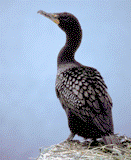United States Department of Agriculture, National Wildlife Research Center: Symposia

Symposium on Double-Crested Cormorants: Population Status and Management Issues in the Midwest
Date of this Version
December 1997
Abstract
We examined 4,848 regurgitated digestive pellets of double-crested cormorants (Phalacrocorax auritus) over a 6-year period (1992–97) to estimate annual predation on sport and other fishes in the eastern basin of Lake Ontario. We found more than 51,000 fish of 28 species. Using a model that incorporates annual colony nest counts; fledgling production rates; adult, immature, and young-of-year residence times (seasonal); estimates of mean number of fish per pellet and mean fish size; and a fecal pathway correction factor (4.0 percent), we estimate total annual number of fish consumed by cormorants in the eastern basin of Lake Ontario to range from 37 million to 128 million fish for 1993–97. This fish loss equates to an estimated 0.93 million to 3.21 million kg (mean 2.07 million kg) of fish consumed per year, principally alewife (Alosa pseudoharengus, 42.3 percent) and yellow perch (Perca flavescens, 18.4 percent). Forage fish (alewife, cyprinids, trout-perch [Percopsis omiscomaycus], and other minor components) accounted for 65 percent of the diet, and panfish contributed 34 percent of the diet for the 5-year period. Game fish were minor components of the diet, in view of an average estimated annual consumption of 900,000 smallmouth bass (Micropterus dolomieui, 1.1 percent) and 168,000 salmonines (mostly lake trout, Salvelinus namaycush, 0.2 percent). Cormorant predation on lake trout fingerlings stocked in May 1993 and June 1994 was estimated through the use of coded wire tag recoveries from pellets collected on Little Galloo Island 1 and 4 days after stocking events. We estimated losses of 13.6 percent and 8.8 percent, respectively, of the fish stocked for the two events, an average of 11.2 percent. Such losses may be reduced through alteration of existing stocking practices.

